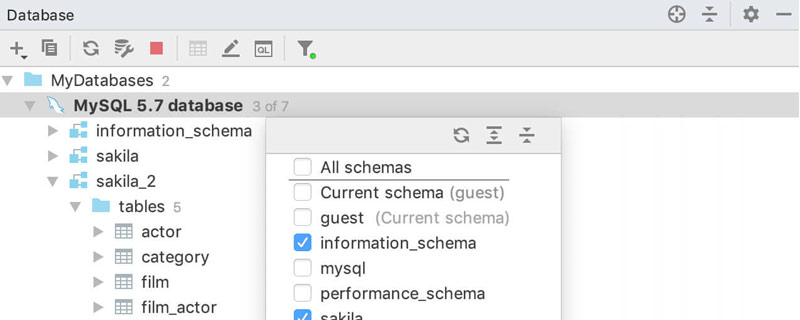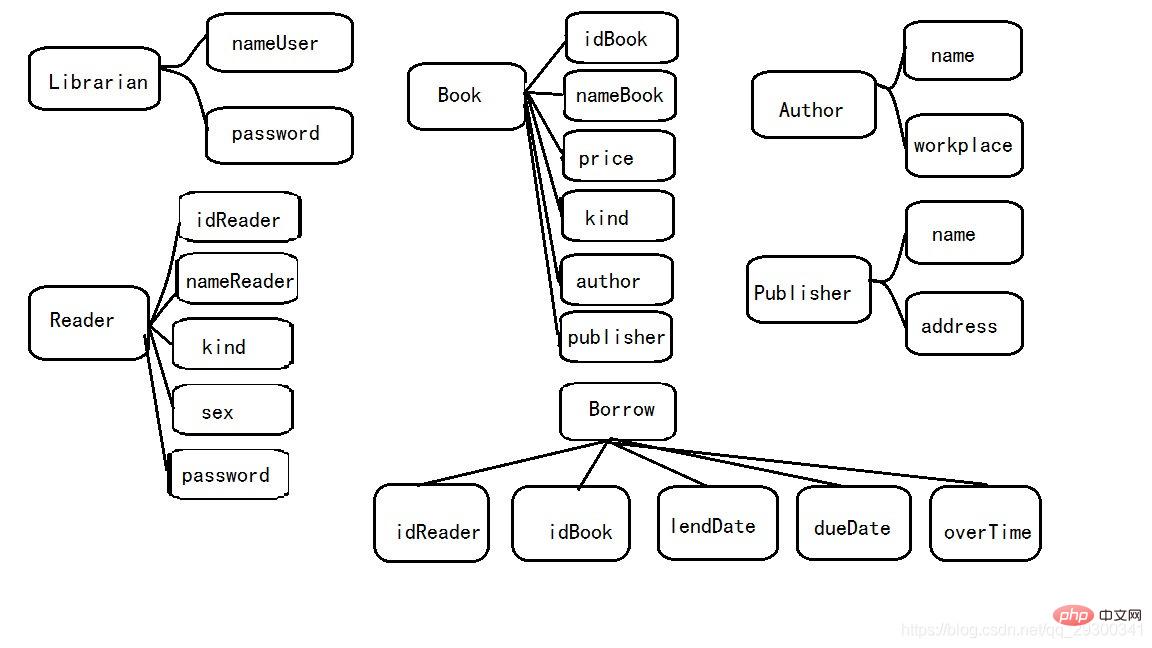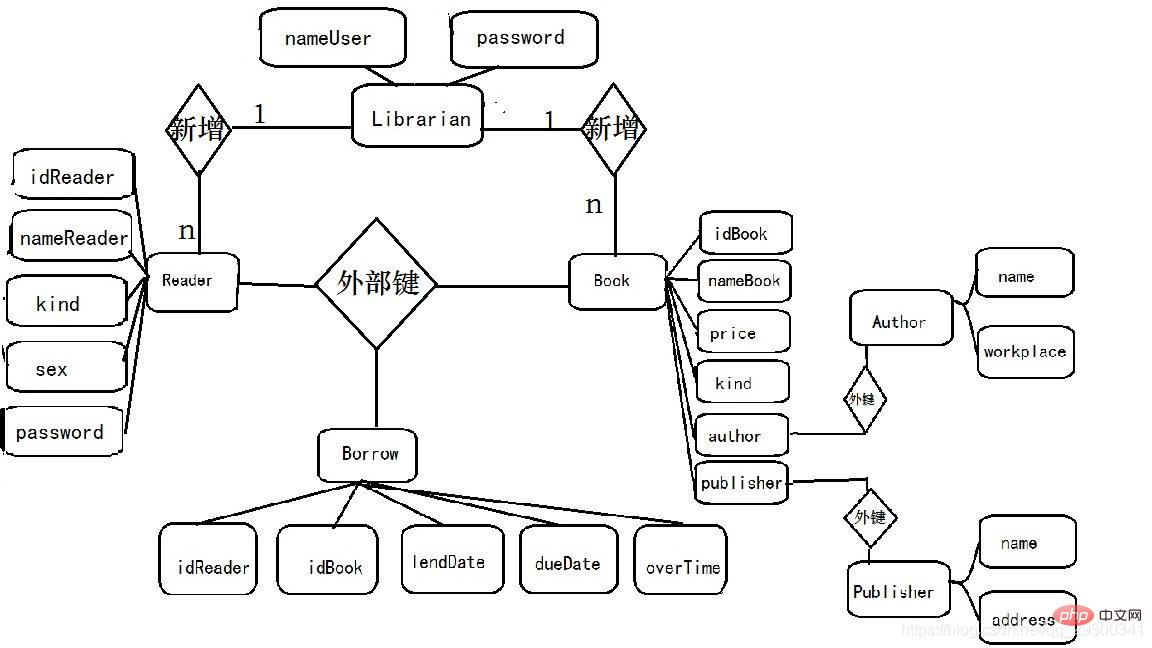Introducing the library management system based on Java and MySQL

Free learning recommendation: mysql video tutorial
##Java Library Management System
Project Requirements
With the popularity of computers and the improvement of application levels, after investigation and comparison, I decided to use my Java knowledge Develop a small library management system to facilitate the management of books. The library management system is a typical information management system. This assignment uses the JAVA development tool Eclipse and MySQL database to develop this library management system. The system solves the problems of library management and can meet the basic requirements of library management, including functions such as addition and management. This system can provide readers with borrowing services quickly and conveniently according to the needs of users
The book management system should have the following functions:
- Reader library management
- Book library management
- Borrowing Management
- Reader Information Query
Project Address
This project address:https://github.com/wangyunpengbio/Library/ Free download method: Click That "Clone or download", then click "Download ZIP". If you are interested, you can click Star
If you are a beginner and don't know how to download, just download it on csdn
https:/ /download.csdn.net/download/qq_29300341/9667678
Requirement analysis
A.Business process:
| Business process | Requirements | |
|---|---|---|
| Librarian login system | Librarians need to log in with their account number and password. | |
| Add reader information | Add reader information, such as name, gender, position, etc. | |
| Add book information | Add book information, such as book title, price, category, etc. | |
| Reader database management | Select the reader information in the reader database to update and delete it. | |
| Book library management | You can press "Book Number Query" and "Book Title Fuzzy Query" and then select the book information. Updating and deleting books are divided into in-store and loaned books | |
| Borrowing Management | Enter the reader number to check the reader's data and borrowing books, review customer data and purchase records. | |
| Reader login system | Readers need to log in with their account number and password. | |
| Borrowing books | Fuzzy search by book title, select to borrow books | |
| Return books | Review your own reader information and the books you have borrowed, just click Return. Changes or deletions of reader data are not allowed. Only query, change and deletion functions are allowed by the administrator. Responsible. |
#The following is analyzed using the Entity Relationship Model-Entity Relationship.
B. Summarize entities and attributes
| Business process | Corresponding entity | Attribute value of the entity | |
|---|---|---|---|
| Librarian login system | Librarian | nameUser password | |
| Add reader information | Reader | idReader nameReader kind sex password | |
| Add book information | Book Author Publisher | idBook,nameBook,price,kind, author,publisher Author.name, Author.workplace Publisher.name, Publisher.address | |
| Reader library management | Reader | idReader nameReader kind sex password | ##5. |
| Book | idBook nameBook price kind autor publisher | 6. | |
| Borrow | idReader idBook lendDate dueDate overtime | 7. | |
| Reader | idReader password | 8 | |
| Borrow | idReader idBook lendDate dueDate overtime | ##9 | |
| Borrow | idReader idBook lendDate dueDate overtime |
C. Entity model
D.ER-Entity relationship Author,Publisher To Book&Borrow&Reader To Librarian ##Design In the project folder, (total code: 4800 lines)doc folder stores the generated Document comments, you can click on the index file to view the comments of the entire project
Note: The entrances to different interfaces of the program have been All are commented out, MainFrame is the only entrance to the program
|
The above is the detailed content of Introducing the library management system based on Java and MySQL. For more information, please follow other related articles on the PHP Chinese website!

Hot AI Tools

Undresser.AI Undress
AI-powered app for creating realistic nude photos

AI Clothes Remover
Online AI tool for removing clothes from photos.

Undress AI Tool
Undress images for free

Clothoff.io
AI clothes remover

Video Face Swap
Swap faces in any video effortlessly with our completely free AI face swap tool!

Hot Article

Hot Tools

Notepad++7.3.1
Easy-to-use and free code editor

SublimeText3 Chinese version
Chinese version, very easy to use

Zend Studio 13.0.1
Powerful PHP integrated development environment

Dreamweaver CS6
Visual web development tools

SublimeText3 Mac version
God-level code editing software (SublimeText3)

Hot Topics
 PHP: A Key Language for Web Development
Apr 13, 2025 am 12:08 AM
PHP: A Key Language for Web Development
Apr 13, 2025 am 12:08 AM
PHP is a scripting language widely used on the server side, especially suitable for web development. 1.PHP can embed HTML, process HTTP requests and responses, and supports a variety of databases. 2.PHP is used to generate dynamic web content, process form data, access databases, etc., with strong community support and open source resources. 3. PHP is an interpreted language, and the execution process includes lexical analysis, grammatical analysis, compilation and execution. 4.PHP can be combined with MySQL for advanced applications such as user registration systems. 5. When debugging PHP, you can use functions such as error_reporting() and var_dump(). 6. Optimize PHP code to use caching mechanisms, optimize database queries and use built-in functions. 7
 MySQL: An Introduction to the World's Most Popular Database
Apr 12, 2025 am 12:18 AM
MySQL: An Introduction to the World's Most Popular Database
Apr 12, 2025 am 12:18 AM
MySQL is an open source relational database management system, mainly used to store and retrieve data quickly and reliably. Its working principle includes client requests, query resolution, execution of queries and return results. Examples of usage include creating tables, inserting and querying data, and advanced features such as JOIN operations. Common errors involve SQL syntax, data types, and permissions, and optimization suggestions include the use of indexes, optimized queries, and partitioning of tables.
 PHP vs. Other Languages: A Comparison
Apr 13, 2025 am 12:19 AM
PHP vs. Other Languages: A Comparison
Apr 13, 2025 am 12:19 AM
PHP is suitable for web development, especially in rapid development and processing dynamic content, but is not good at data science and enterprise-level applications. Compared with Python, PHP has more advantages in web development, but is not as good as Python in the field of data science; compared with Java, PHP performs worse in enterprise-level applications, but is more flexible in web development; compared with JavaScript, PHP is more concise in back-end development, but is not as good as JavaScript in front-end development.
 MySQL's Place: Databases and Programming
Apr 13, 2025 am 12:18 AM
MySQL's Place: Databases and Programming
Apr 13, 2025 am 12:18 AM
MySQL's position in databases and programming is very important. It is an open source relational database management system that is widely used in various application scenarios. 1) MySQL provides efficient data storage, organization and retrieval functions, supporting Web, mobile and enterprise-level systems. 2) It uses a client-server architecture, supports multiple storage engines and index optimization. 3) Basic usages include creating tables and inserting data, and advanced usages involve multi-table JOINs and complex queries. 4) Frequently asked questions such as SQL syntax errors and performance issues can be debugged through the EXPLAIN command and slow query log. 5) Performance optimization methods include rational use of indexes, optimized query and use of caches. Best practices include using transactions and PreparedStatemen
 Why Use MySQL? Benefits and Advantages
Apr 12, 2025 am 12:17 AM
Why Use MySQL? Benefits and Advantages
Apr 12, 2025 am 12:17 AM
MySQL is chosen for its performance, reliability, ease of use, and community support. 1.MySQL provides efficient data storage and retrieval functions, supporting multiple data types and advanced query operations. 2. Adopt client-server architecture and multiple storage engines to support transaction and query optimization. 3. Easy to use, supports a variety of operating systems and programming languages. 4. Have strong community support and provide rich resources and solutions.
 PHP vs. Python: Core Features and Functionality
Apr 13, 2025 am 12:16 AM
PHP vs. Python: Core Features and Functionality
Apr 13, 2025 am 12:16 AM
PHP and Python each have their own advantages and are suitable for different scenarios. 1.PHP is suitable for web development and provides built-in web servers and rich function libraries. 2. Python is suitable for data science and machine learning, with concise syntax and a powerful standard library. When choosing, it should be decided based on project requirements.
 PHP: The Foundation of Many Websites
Apr 13, 2025 am 12:07 AM
PHP: The Foundation of Many Websites
Apr 13, 2025 am 12:07 AM
The reasons why PHP is the preferred technology stack for many websites include its ease of use, strong community support, and widespread use. 1) Easy to learn and use, suitable for beginners. 2) Have a huge developer community and rich resources. 3) Widely used in WordPress, Drupal and other platforms. 4) Integrate tightly with web servers to simplify development deployment.
 How to connect to the database of apache
Apr 13, 2025 pm 01:03 PM
How to connect to the database of apache
Apr 13, 2025 pm 01:03 PM
Apache connects to a database requires the following steps: Install the database driver. Configure the web.xml file to create a connection pool. Create a JDBC data source and specify the connection settings. Use the JDBC API to access the database from Java code, including getting connections, creating statements, binding parameters, executing queries or updates, and processing results.









